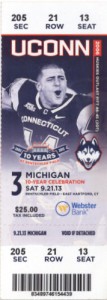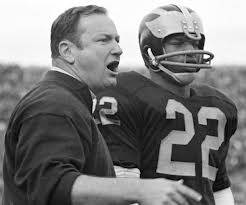I am of two minds about college football. Continue reading
- Oregon had just enough left in the tank to pull out a victory over Oregon State in the Civil War.
- San Jose State (a team with a losing record!) hung up 62 points on previously undefeated Fresno State.
- My proud Wolverines came up just short against the obnoxious brats from that state to the south.
- LSU looked horrible, but they still managed to eke out a last-minute victory over Arkansas, a team that has not won a conference game in a year and a half.
- Penn State somehow ruined Wisconsin’s season, and that one came on the victim’s home turf.
- Georgia Tech’s forty-year old offense gave Georgia fits for four quarters, but it could not produce the necessary touchdown in overtime.
- Missouri held off Texas A&M in what barely passed for a good game. After all, the Tigers won by a whole touchdown.
- For the second week in a row Auburn produced the most miraculous finish in the history of college football. This time the Tigers/War Eagles/Plainsmen were helped by repeated cerebral-rectal inversions by the Alabama coach, Nick Saban, who is (or at least was) universally acknowledged as a genius.
- There were others, too. I did not even mention South Carolina-Clemson, USC-UCLA, Stanford-Notre Dame, and Duke’s improbable rise to power.
Simply put, college football consistently produces dramatic, even spell-binding games, at least when two teams that hate one another are paired. What other sport even comes close? The looks on the faces of the fans made it clear that nothing in sports, at least in the United States, generates the kind of excitement that college football at the top level routinely delivers. The only rivalry in any other American sport that would even rank in the top ten is that of the Red Sox and the Yankees, and no one outside of the northeast could conceivably care that much about whether the millionaires in the Bronx are better or worse than the ones in Fenway.
Aside from the excitement, I have also found college football to be a more interesting game as well. There are passing teams and running teams. Some teams play as fast as they can. Some are deliberate. Historically, the skill of the head coach has been more important than the composition of the team. Of course, there have always been stars, but the ability of the coach to get the players to work together to implement his system has usually been the dominant factor.
Finally, the players have for the most part always been real students. They may have had some important advantages in terms of curriculum, tutoring and counseling, but they took classes in the same buildings as the other students. Thom Darden, a future Pro Bowler (and five other guys with football scholarships) lived in the same dorm of about one hundred guys that I did. Darden even played on our intramural basketball team. The bond between graduates and top-level football programs is strong enough to last a lifetime.
A separate but related phenomenon is the emphasis on star players. The most obvious example is Cam Newton, who began his college career at the University of Florida. Some legal problems got him suspended from the team in his sophomore year. He transferred to Blinn College in Texas and led that team to the junior college national championship. I do not know why he did not return to Florida. Instead he signed with Auburn while his father tried to get Mississippi State to give him a large sum of money to assure his son’s presence at that institution. Newton led an undefeated Auburn team to the national championship in 2010. After he left, the team’s fortunes immediately turned south. Two years later they went winless in the SEC. It is definitely worth noting that Newton’s coach, Gene Chizik, was coach of the year in 2010 and fired in 2012. Don’t feel too bad about him. Auburn had to pay Chizik $7.5 million to buy him out of his contract.
Television has made this worse. Not only do the announcers make excessive use of superlatives in describing the players, the networks themselves sponsor all-star games for the high school players in which several of them perform the hats-on-the-table ritual. Meanwhile the rating services award stars to and keep statistics on everyone who has ever touched the pigskin.
And are today’s college football players even really students? I am much too removed from campus life to judge, but I read that the winner of last year’s Heisman Trophy, Johnny Manziel of Texas A&M, took only online courses (in his major, sports management) last spring. He explained that he did this because of all the attention that he was getting. Can you imagine? He wanted to avoid interacting with adoring students, 47.9 percent of which are female at A&M! O tempora, o mores!
The success of Newton, Manziel, and a few others has led some coaches to pursue prospective players with abandon. Offers are being made to players in junior high school or even younger. The best high school players have college recruiters lined up to worship at their feet. When a school is looking for a head coach, the most important factor is often how good the coach is at closing the deal in the living room of the prospective player. The players themselves often decide based on how much attention has been played to them.
I remember hearing a backfield coach at Texas proclaiming a few years ago that if he did not have a certain level of talent to work with, he could not coach. Nonsense. In fact, I have a simple solution to this problem. Just eliminate recruiting altogether. Let the athletes apply to the schools that they like, and let the schools offer athletic scholarships. Eliminate recruiting trips entirely. The students could visit the schools, of course, but the coaches could not visit them at all. Any telephone, e-mail, or social media correspondence would have to be initiated by the student. Coaches would hate this. They would need to do a lot more coaching, and sometimes they would end up with too much talent at certain positions and not enough at others. So what?
Another issue is the size and power of the players. As late as the seventies, almost no pros weighed 300 pounds. Now plenty of high school linemen top that figure, and almost every major college offensive line averages more than 300. A running back who weighs less than 220 pounds is considered skinny. These guys spend an inordinate amount of time lifting weights. They all look like body builders.
I think that the game would be a lot better if teams were only allowed one or two substitutions per play, even when the ball changed hands. Make the players play both ways. Injuries would go way down, guys that can do nothing but block (like the crew that Alabama had on the field for the fatal field goal attempt last Saturday) would be considered much less valuable. Overall athletic ability, not the ability to do one thing preternaturally well, and strategy would be rewarded. Isn’t that a good thing? These are supposed to be academic institutions, after all.
Finally, I regret the demise of the conferences. When I was in college the conferences meant something: Atlantic Coast, Southeast, Southwest, Big 8, Big 10, and Pac 8. Each was regional, and each had its own personality. Now, fergodsake, the Big XII has ten teams, and the Big 10 has twelve. Furthermore, Rutgers and Maryland will join the Big 10 next year. Rutgers and Maryland! Missouri is now in the SEC, and West Virginia has somehow joined the Big XII. The Pac in Pac 12 no longer stands for Pacific unless you think that Boulder, CO, is on the West Coast. I have no idea which teams are in the ACC. Unfortunately, this cat is out of the bag, and the concept of a regional conference will never be regained.
As much as I despise what college football has become, I still watch all the games (except Michigan games; I get too nervous).


